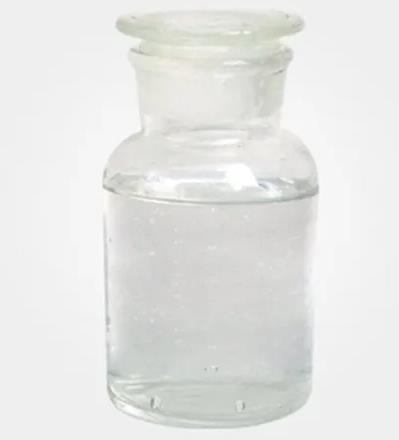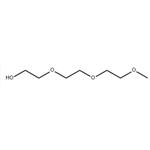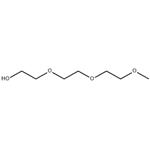Application research of Triethylene glycol monomethyl ether
Introduction
Triethylene glycol monomethyl ether (TGME;Figure 1) is a commonly used thinner in the synthesis of borate type brake fluid, which accounts for a large proportion in different types of borate type brake fluids, and currently no other substitutes could be found due to its special physical properties. The only route in the industry to synthesize triethylene glycol monomethyl ether is via the reaction of ethylene oxide with methanol. However, this reaction co-produces ethylene glycol monomethyl ether, diethylene glycol monomethyl ether,and polyglycol monomethyl ether, with a poor selectivity to the desired product. In addition, ethylene oxide itself is flammable and explosive, which is not conducive to the production safety. Following the rapid development of the automotive industry,the demand for borate type brake fluid continues to increase. It is necessary to research and develop other synthetic routes for triethylene glycol monomethyl ether. [1]

Synthesis of Triethylene Glycol Monomethyl Ether
In line with this, Huang and his colleague proposes a route to synthesize triethylene glycol monomethyl ether using triethylene glycol (TEG) and methanol at normal pressure and lower temperature, initiated by process intensification since it is a reversible reaction. Firstly, an apparatus considering the process intensification was established for synthesis of triethylene glycol monomethyl ether by TEG and methanol, Then, various catalysts were tested for screening a catalyst A for this reaction. Finally, the reaction conditions were optimized. Results show that the reaction temperature at 110℃, the catalyst with 20% of the amount of TEG added, and the reaction time of 12 h gave the molar conversion of TEG of 37.7% and the selectivity of 95.6% to TGME, where the only by-product is triethylene glycol dimethyl ether which can also be used as a brake fluid thinner.[1]
Triethylene glycol monomethyl ether As Icina Inhibitor For Jet Fuel
Icing inhibitor can prevent dissolved water in jet fuel from precipitating and freezing at low temperature. Due to the low vapor pressure of diethylene glycol monomethyl ether(DiEGME) used at present,the epoxy resin coating is affected,which has potential safety hazards. In this paper,the performance of triethylene glycol monomethyl ether(TriEGME) as anti-icing agent for jet fuel and its influence on several coatings are preliminarily evaluated. The results show that triethylene glycol monomethyl ether has good anti-icing performance,and has little influence on the coating,so it may be used as a new anti-icing agent.[2]
Triethylene glycol monomethyl ether disperse carbon black
Dielectric elastomer actuators (DEAs) have been proposed as a promising technology for developing soft robotics and stretchable electronics due to their large actuation. Among available fabrication techniques, inkjet printing is a digital, mask-free, material-saving, and fast technology, making it versatile and appealing for fabricating DEA electrodes. However, there is still a lack of suitable materials for inkjet-printed electrodes. In this study, multiple carbon black (CB) inks were developed and tested as DEA electrodes inkjet-printed on acrylic membranes (VHB). Triethylene glycol monomethyl ether (TGME) and chlorobenzene (CLB) were selected to disperse CB. The inks' stability, particle size, surface tension, viscosity, electrical resistance, and printability were characterized. The DEA with Ink-triethylene glycol monomethyl ether(TGME)/CLB (mixture solvent) electrodes obtained 80.63% area strain, a new benchmark for the DEA actuation with CB powder electrodes on VHB. The novelty of this work involves the disclosure of a new ink recipe (triethylene glycol monomethyl ether/CLB/CB) for inkjet printing that can obtain stable drop formations with a small nozzle (17×17μm), high resolution (-25μm, approaching the limit of drop-on-demand inkjet printing), and the largest area strain of DEAs under similar conditions, distinguishing this contribution from the previous works, which is important for the fabrication and miniaturization of DEA-based soft and stretchable electronics.[3]
Synthesis of Novel Polycations
An alarming increase of antibiotic resistance among pathogens creates an urgent need to develop new antimicrobial agents. Many reported polycations show high antimicrobial activity along with low hemolytic activity. Unfortunately, most of those molecules remain highly cytotoxic against various mammalian cells. In this work, a systematic study on the impact of triethylene glycol monomethyl ether side groups (short polyethylene glycol (PEG) analog) on antimicrobial, hemolytic, and cytotoxic properties of novel amphiphilic ionenes is presented. A detailed description of synthesis, leading to well-defined alternating polymers, which differ in structural elements responsible for hydrophilicity (PEG) and hydrophobicity (alkyl chain), is presented. Obtained results show that the PEG moiety and fine-tuned hydrophilic-lipophilic balance of ionenes synergistically lead to low cytotoxic, low hemolytic molecules with high activity against S. aureus, including methicillin-resistant strains (MRSA). Additionally, the results of mechanistic studies on bacterial cells and fluorescently labeled liposomes are also discussed.[4]
Amphiphilic π-Conjugated Polymer Nanoparticles preparation
Novel amphiphilic π-conjugated polymer nanoparticles tailored to efficiently absorb in the near-infrared II (NIR-II) region of the electromagnetic spectrum (>1000 nm) are presented. To achieve this, it is statistically introduced triethylene glycol substituted bithiophene moieties in various contents into a polymer backbone consisting of alternating thiophene and [1,2,5]thiadiazolo[3,4-g]quinoxaline. Through systematic modifications of monomer ratios, four amphiphilic conjugated polymers are produced. The presence of hydrophilic side chain, like triethylene glycol monomethyl ether, enhanced the polymer's concentration in aqueous media of up to 470%, versus the D-A thiophene and [1,2,5]thiadiazolo[3,4-g]quinoxaline hydrophobic analog polymer, enabling the production of surfactant-free conjugated polymer nanoparticles (CPNs) with higher concentrations (20.3 ppm maximum). Subsequently, the impact of this structural fine-tuning on the optical properties of the polymers and their corresponding CPNs are meticulous investigated. In both cases, it is identified the minimum bithiophene content that maintained the absorption spectra above 1000 nm at significantly higher concentrations. So, these findings contribute to the extensive prospects of these materials in multiple fields including biomedical and optoelectronic applications.[5]
References
1.Huang GM.Synthesis of Triethylene Glycol Monomethyl Ether and Its Separation with Supereritical Fluid Extraction[D].Xiamen University,2020.DOI:10.27424/d.cnki.gxmdu.2020.003412.
2.Li JL,et al.The Research On Teiethylene Glycol Monomethyl Ether As Icina Inhibitor For Jet Fuel[J].Petrochemical Industry Technology,2021,28(09):13-14+25.
3.Yi J, Babick F, Strobel C, et al. Characterizations and Inkjet Printing of Carbon Black Electrodes for Dielectric Elastomer Actuators. ACS Appl Mater Interfaces. 2023;15(35):41992-42003. doi:10.1021/acsami.3c05444
4.Kopiasz RJ, Kulbacka N, Drężek K, et al. Influence of PEG Subunit on the Biological Activity of Ionenes: Synthesis of Novel Polycations, Antimicrobial and Toxicity Studies. Macromol Biosci. 2022;22(7):e2200094. doi:10.1002/mabi.202200094
5.Schiza A, Nega A, Dimitrakopoulou-Strauss A, Gregoriou VG, Chochos CL. Surfactant-Free Stable Aqueous Shortwave Infrared Amphiphilic π-Conjugated Polymer Nanoparticles. Macromol Rapid Commun. 2025;46(6):e2400739. doi:10.1002/marc.202400739
Lastest Price from TRIETHYLENE GLYCOL MONOMETHYL ETHER manufacturers

US $1.00/KG2025-09-12
- CAS:
- 112-35-6
- Min. Order:
- 1KG
- Purity:
- 99%
- Supply Ability:
- 10000KG

US $0.00/drum2025-05-16
- CAS:
- 112-35-6
- Min. Order:
- 200drum
- Purity:
- 99%
- Supply Ability:
- 20000


